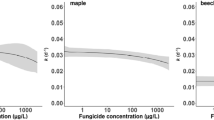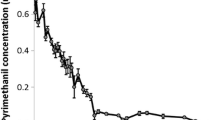Abstract
We investigated microbial interactions of aquatic bacteria associated with hyphae (the hyphosphere) of freshwater fungi on leaf litter. Bacteria were isolated directly from the hyphae of fungi from sedimented leaves of a small stream in the National Park “Lower Oder,” Germany. To investigate interactions, bacteria and fungi were pairwise co-cultivated on leaf-extract medium and in microcosms loaded with leaves. The performance of fungi and bacteria was monitored by measuring growth, enzyme production, and respiration of mono- and co-cultures. Growth inhibition of the fungus Cladosporium herbarum by Ralstonia pickettii was detected on leaf extract agar plates. In microcosms, the presence of Chryseobacterium sp. lowered the exocellulase, endocellulase, and cellobiase activity of the fungus. Additionally, the conversion of leaf material into microbial biomass was retarded in co-cultures. The respiration of the fungus was uninfluenced by the presence of the bacterium.






Similar content being viewed by others
References
Anderson RC, Liberta AE, Packheiser J, Neville ME (1980) Inhibition of selected fungi by bacterial isolates from Trispsacum dactyloides L. Plant and Soil 56:149–152
Altschul SF, Madden TL, Schäffer AA, Zhang J, Zhang Z, Miller W, Lipman DJ (1997) Gapped BLAST and PSI-BLAST: a new generation of protein database search programs. Nucleic Acids Res 25:3389–3402
Bärlocher F (1992) Research on aquatic hyphomycetes: historical background and overview. In: Bärlocher F (ed) The ecology of aquatic hyphomycetes. Springer, Berlin, pp 1–15
Baldy V, Gessner MO (1997) Towards a budget of leaf litter decomposition in a first-order woodland stream. C R Acad Sci, Ser III Sci Vie/Life Sci 320:747–758
Baldy V, Gessner MO, Chauvet E (1995) Bacteria, fungi and the breakdown of leaf litter in a large river. Oikos 74:93–102
Barron GL (1988) Microcolonies of bacteria as a nutrient source for lignicolous and other fungi. Can J Bot 66:2505–2510
Bengtsson G (1992) Interactions between fungi, bacteria and beech leaves in a stream microcosm. Oecologia 89:542–549
Bernardet JF, Segers P, Vancanneyt M, Berthe F, Kersters K, Vandamme P (1996) Cutting a Gordian Knot: emended classification and description of the genus Flavobacterium, emended description of the family Flavobacteriaceae, and proposal of Flavobacterium hydatis nom. Nov. (basonym, Cytophaga aquatilis Strohl and Tait 1978). Int J Syst Bacteriol 46(1):128–148
Bianciotto V, Lumini E, Lanfranco L, Minerdi D, Bonfante P, Perotto S (2000) Detection and identification of bacterial endosymbionts in arbuscular mycorrhizal fungi belonging to the family gigasporaceae. App Environ Microbiol 66:4503–4509
Biebl H, Pfennig N (1978) Growth yields of green sulfur bacteria in mixed cultures with sulfur and sulfate reducing bacteria. Arch Microbiol 117:9–16
De Boer WJH, Leveau J, Kowalchuk GA, Klein Gunnewiek PJA, Abeln ECA, Figge MJ, Sjollema K, Janse JD, van Veen JA (2004) Collimonas fungivorans gen. nov., sp. nov., a chitinolytic soil bacterium with the ability to grow on living fungal hyphae. Int J Syst Evol Microbiol 54:857–864
De Boer W, Folman LB, Summerbell RC, Boddy L (2005) Living in a fungal world: impact of fungi on soil bacterial niche development. FEMS Microbiol Rev 29(4):795–811
Domsch KH, Gams W, Anderson T-H (2007) Compendium of soil fungi, 2nd edn. IHW, Eching, pp 142–144
Gams W, Hoekstra ES, Aptroot A (1998) CBS course of mycology. Centraalbureau voor Schimmelcultures Baarn, Delft
Gulis VI, Stephanowich AI (1999) Antibiotic effects of some aquatic hyphomycetes. Mycol Res 103:111–115
Gulis V, Suberkropp K (2003) Interactions between stream fungi and bacteria associated with decomposing leaf litter at different levels of nutrient availability. Aquat Microb Ecol 30:149–157
Kaida K, Fudou R, Kameyama T, Tubaki K, Suzuki Y, Ojika M, Sakagami Y (2001) New cyclic depsipeptide antibiotics, clavariopsins A and B, produced by an aquatic hyphomycete, Clavariopsis aquatica 1. Taxonomy, fermentation, isolation, and biological properties. J Antibiot 54:17–21
Lane DJ (1991) 16s/23s rRNA sequencing. In: Stackebrand E, Goodfellow M (eds) Nucleic acid techniques in bacterial systematics. Wiley, New York, pp 115–175
Lawrence JR, Neu TR (2003) Microscale analyses of the formation and nature of microbial biofilm communities in river systems. Rev Environ Biotechnol 2–4:85–97
Lynd LR, Weimer PJ, van Zyl WH, Pretorius IS (2002) Microbial cellulose utilization: fundamentals and biotechnology. Microbiol Mol Biol Rev 66:506–577
Makkar HPS, Singh B (1992) Effect of Steaming and Autoclaving Oak (Quercus incana) leaves on levels of tannins, fibre and lignin and in-sacco dry matter digestibility. J Sci Food Agric 59:469–472
Mille-Lindblom C, Tranvik LJ (2003) Antagonism between bacteria and fungi on decomposing aquatic plant litter. Microb Ecol 45:73–182
Mille-Lindblom C, Fischer H, Tranvik LJ (2006) Antagonism between bacteria and fungi: substrate competition and a possible tradeoff between fungal growth and tolerance towards bacteria. Oikos 113:233–242
Møller J, Miller M, Kjøller A (1999) Fungal-bacterial interaction on beech leaves: influence on decomposition and dissolved organic carbon quality. Soil Biochem 31:367–374
Motta AS, Cladera-Olivera F, Brandelli A (2004) Screening for antimicrobial activity among bacteria isolated from the Amazon Basin. Braz J Microbiol 35:307–310
Nordgren A (1988) Apparatus for the continuous long-term monitoring of soil respiration rate in large numbers of samples. Soil Biol Biochem 20:955–958
Partida-Martinez L, Monajembashi S, Greulich K, Hertweck C (2007) Endosymbiont-dependent host reproduction maintains bacterial-fungal mutualism. Curr Biol 17:773–777
Platas G, Pelaez F, Collado J, Villuendas G, Diez MT (1998) Screening of antimicrobial activities by aquatic hyphomycetes cultivated on various nutrient sources. Cryptogam Mycol 19:33–43
Raaijmakers JM, Bonsall RF, Weller DM (1999) Effect of population density of Pseudomonas fluorescens on production of 2, 4-diacetylphloroglucinol in the rhizosphere of wheat. Phytopathology 89:470–475
Romaní AM, Fischer H, Mille-Lindblom C, Tranvik LJ (2006) Interactions of bacteria and fungi on decomposing litter: differential extracellular enzyme activities. Ecology 87:2559–2569
Sambrook J, Russel DW (2001) Molecular Cloning—a laboratory manual. CSHL, Cold Spring Harbour, p 16.15
Shearer CA, Zare-Mavian H (1988) In vitro hyphal interactions among wood- and leaf-inhabiting Ascomycetes and Fungi Imperfecti from freshwater habitats. Mycologia 80:31–37
Srivastava AK, Arora DK, Gupta S, Pandey RR, Lee MW (1996) Diversity of potential microbial parasites colonizing sclerotia of Macrophomina phaseolina in soil. Biol Fert Soils 22:136–140
Staněk M (1984) Microorganisms in the hyphosphere of fungi. I. Introduction. Czech Mycol 38:1–10
Stelzmueller I, Biebl M, Wiesmayr S, Eller M, Hoeller E, Fille M, Weiss G, Lass-Floerl C, Bonatti H (2006) Ralstonia pickettii-innocent bystander or a potential threat? Clin Microb Infect 12:99–102
Suberkropp K, Klug MJ (1976) Fungi and bacteria associated with leaves during processing in a woodland stream. Ecology 57:707–719
Sutherland IW (1977) Bacterial exopolysaccharides, their nature and production. In: Sutherland W (ed) Surface carbohydrates of the prokaryotic cell. Academic, London, pp 27–96
Vilgalys R, Hester M (1990) Rapid genetic identification and mapping of enzymatically amplified ribosomal DNA from several Cryptococcus species. J Bacteriol 172:4238–4246
Weyers HS, Suberkropp K (1996) Fungal and bacterial production during the breakdown of yellow poplar leaves in 2 streams. J N Am Benthol Soc 15:408–420
Whipps JM (2001) Microbial interactions and biocontrol in the rhizosphere. J Exp Bot 52:487–511
Whitehead NA, Barnard AML, Slater H, Simpson NJL, Salmond GPC (2001) Quorum-sensing in Gram-negative bacteria. FEMS Microb Rev 25:365–404
Wohl DL, McArthur JV (2001) Aquatic actinomycete-fungal interactions and their effects on organic matter decomposition: a microcosm study. Microb Ecol 42:446–457
Acknowledgements
We are very grateful to Maike Mai (TU Berlin Department of Waste Management and Environmental Research) who attended the respiration rate measurements. We are also very thankful for the aid of Sabine Rautenberg (TU Berlin Department of Soil Science) with the chromatography analysis. We thank Joseph Bishop of the University of Missouri-Rolla, USA for revising the English language of the manuscript.
Author information
Authors and Affiliations
Corresponding author
Rights and permissions
About this article
Cite this article
Baschien, C., Rode, G., Böckelmann, U. et al. Interactions Between Hyphosphere-Associated Bacteria and the Fungus Cladosporium herbarum on Aquatic Leaf Litter. Microb Ecol 58, 642–650 (2009). https://doi.org/10.1007/s00248-009-9528-6
Received:
Accepted:
Published:
Issue Date:
DOI: https://doi.org/10.1007/s00248-009-9528-6




